from Apr. 30, 1865
The Southern Sentinel, April 30, 1865
-
Full Title
The Southern Sentinel, April 30, 1865
-
Description
Confederate newspaper containing dispatches from various Northern newspapers regarding the assassination of President Abraham Lincoln and the attempted assassination of Secretary William H. Seward. Editorial titled "The Assassination of Lincoln" states: "Two weeks since we designated Lincoln as a despicable despot, and our opinion of him is unchanged by his death, which at an earlier date had it occurred in any other way, we should have rejoiced at, as the enemy of the South and the rights we are contending for. Our feelings and principles revolt alike however, at the infamous and cowardly crime by which he was cut off..."
-
Source
HN-1865-011152B
-
Rights
Use of this item for research, teaching, and private study is permitted with proper citation and attribution as follows: Courtesy, Newseum Collection. Reproduction of this item for publication, broadcast, or commercial use requires written permission. For permission, please contact us at artifacts@newseum.org.
-
Tags
-
Cite this Item
T.G. Compton. "The Southern Sentinel, April 30, 1865". T.G. Compton. Remembering Lincoln. Web. Accessed October 29, 2025. https://rememberinglincoln.fords.org/node/629
from Apr. 30, 1865
The Southern Sentinel, April 30, 1865
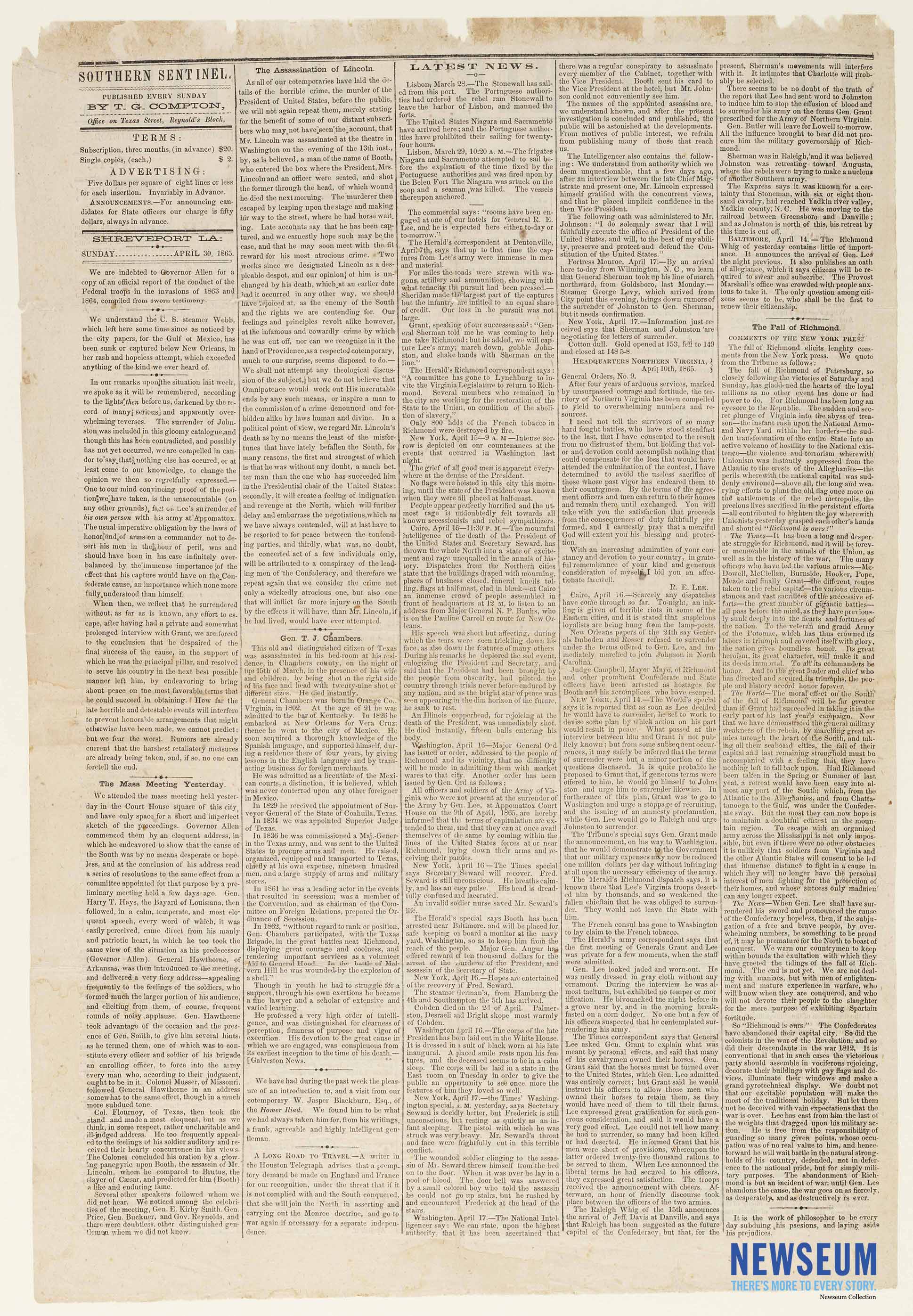
-
Description
Confederate newspaper containing dispatches from various Northern newspapers regarding the assassination of President Abraham Lincoln and the attempted assassination of Secretary William H. Seward. Editorial titled "The Assassination of Lincoln" states: "Two weeks since we designated Lincoln as a despicable despot, and our opinion of him is unchanged by his death, which at an earlier date had it occurred in any other way, we should have rejoiced at, as the enemy of the South and the rights we are contending for. Our feelings and principles revolt alike however, at the infamous and cowardly crime by which he was cut off..."
-
Source
HN-1865-011152B
-
Rights
Use of this item for research, teaching, and private study is permitted with proper citation and attribution as follows: Courtesy, Newseum Collection. Reproduction of this item for publication, broadcast, or commercial use requires written permission. For permission, please contact us at artifacts@newseum.org.
-
Creator
T.G. Compton
-
Publisher
T.G. Compton
-
Date
April 30, 1865
-
Material
Newspaper
from Apr. 20, 1865
The Weekly Reporter, April 20, 1865
-
Full Title
The Weekly Reporter, April 20, 1865
-
Description
Front page report providing extensive details on the assassination of President Abraham Lincoln and the attempted assassination of Secretary William H. Seward. The newspaper contains the official 1:30 a.m. and 4:10 a.m. dispatches from Secretary of War Edwin M. Stanton to Major General John A. Dix, as well as the 7:22 a.m. report of Lincoln's death. Known as "mourning rules," the wide vertical lines between the newspaper columns represent grief over the loss of an important person.
-
Source
HN-1865-011104
-
Rights
Use of this item for research, teaching, and private study is permitted with proper citation and attribution as follows: Courtesy, Newseum Collection. Reproduction of this item for publication, broadcast, or commercial use requires written permission. For permission, please contact the Newseum.
-
Tags
-
Cite this Item
Spidel & Staples. "The Weekly Reporter, April 20, 1865". Spidel & Staples. Remembering Lincoln. Web. Accessed October 29, 2025. https://rememberinglincoln.fords.org/node/628
from Apr. 20, 1865
The Weekly Reporter, April 20, 1865
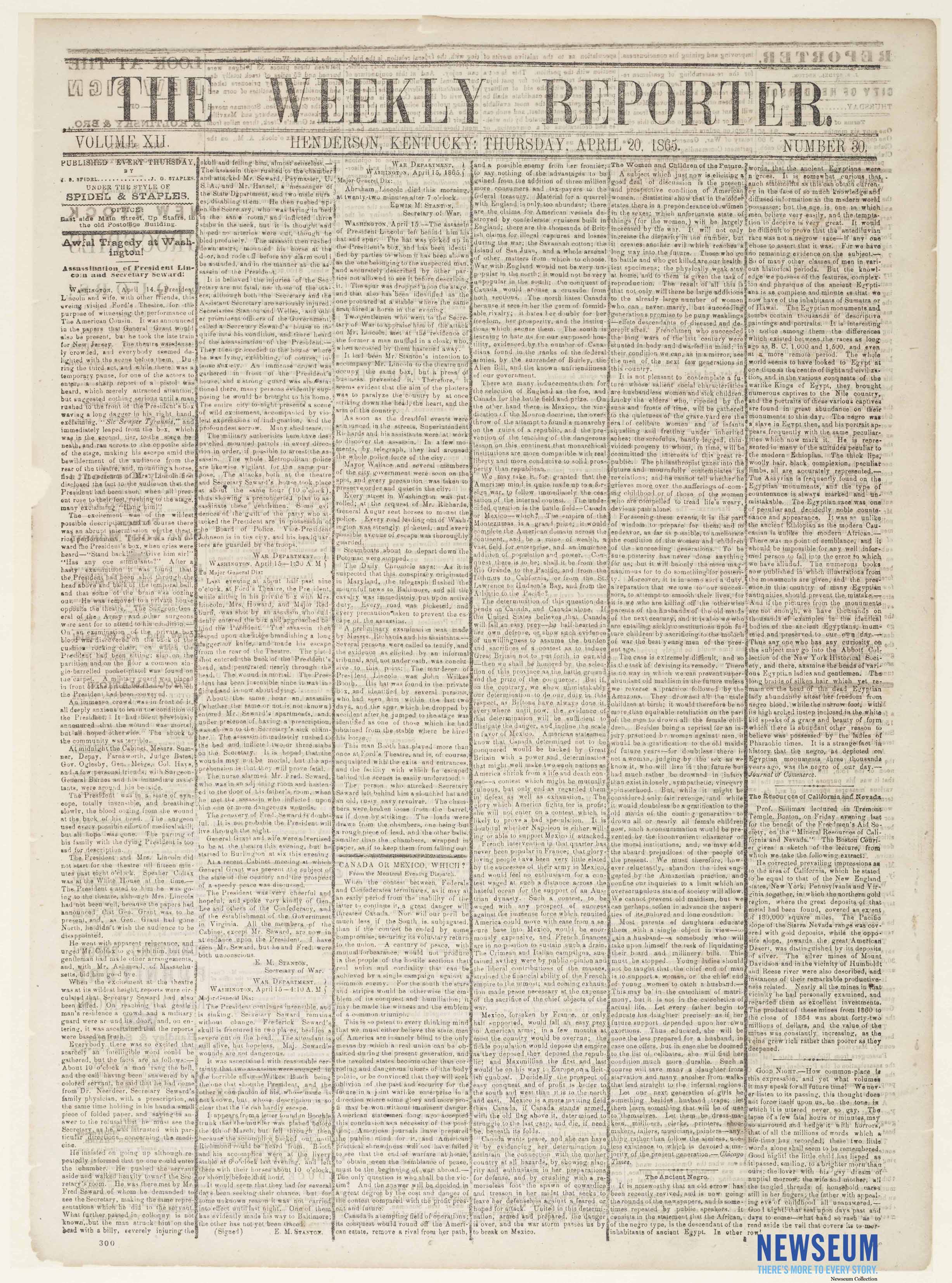
-
Description
Front page report providing extensive details on the assassination of President Abraham Lincoln and the attempted assassination of Secretary William H. Seward. The newspaper contains the official 1:30 a.m. and 4:10 a.m. dispatches from Secretary of War Edwin M. Stanton to Major General John A. Dix, as well as the 7:22 a.m. report of Lincoln's death. Known as "mourning rules," the wide vertical lines between the newspaper columns represent grief over the loss of an important person.
-
Source
HN-1865-011104
-
Rights
Use of this item for research, teaching, and private study is permitted with proper citation and attribution as follows: Courtesy, Newseum Collection. Reproduction of this item for publication, broadcast, or commercial use requires written permission. For permission, please contact the Newseum.
-
Creator
Spidel & Staples
-
Publisher
Spidel & Staples
-
Date
April 20, 1865
-
Material
Newspaper
from Apr. 15, 1865
Union Extra, April 15, 1865
-
Full Title
Union Extra, April 15, 1865
-
Description
This broadside extra reports on the assassination of President Abraham Lincoln. It falsely states that Secretary William H. Seward was killed and that John Wilkes Booth was arrested. The broadside contains a 4:10 a.m. dispatch from Secretary of War Edwin M. Stanton to Major General John A. Dix with the latest information. There is a report from New York describing the public's grief and the rage "undoubtedly felt towards all known secession and rebel sympathisers [sic]."
-
Source
HN-1865-011084
-
Rights
Use of this item for research, teaching, and private study is permitted with proper citation and attribution as follows: Courtesy, Newseum Collection. Reproduction of this item for publication, broadcast, or commercial use requires written permission. For permission, please contact the Newseum.
-
Tags
-
Cite this Item
[s.n.]. "Union Extra, April 15, 1865". . Remembering Lincoln. Web. Accessed October 29, 2025. https://rememberinglincoln.fords.org/node/627
from Apr. 15, 1865
Union Extra, April 15, 1865
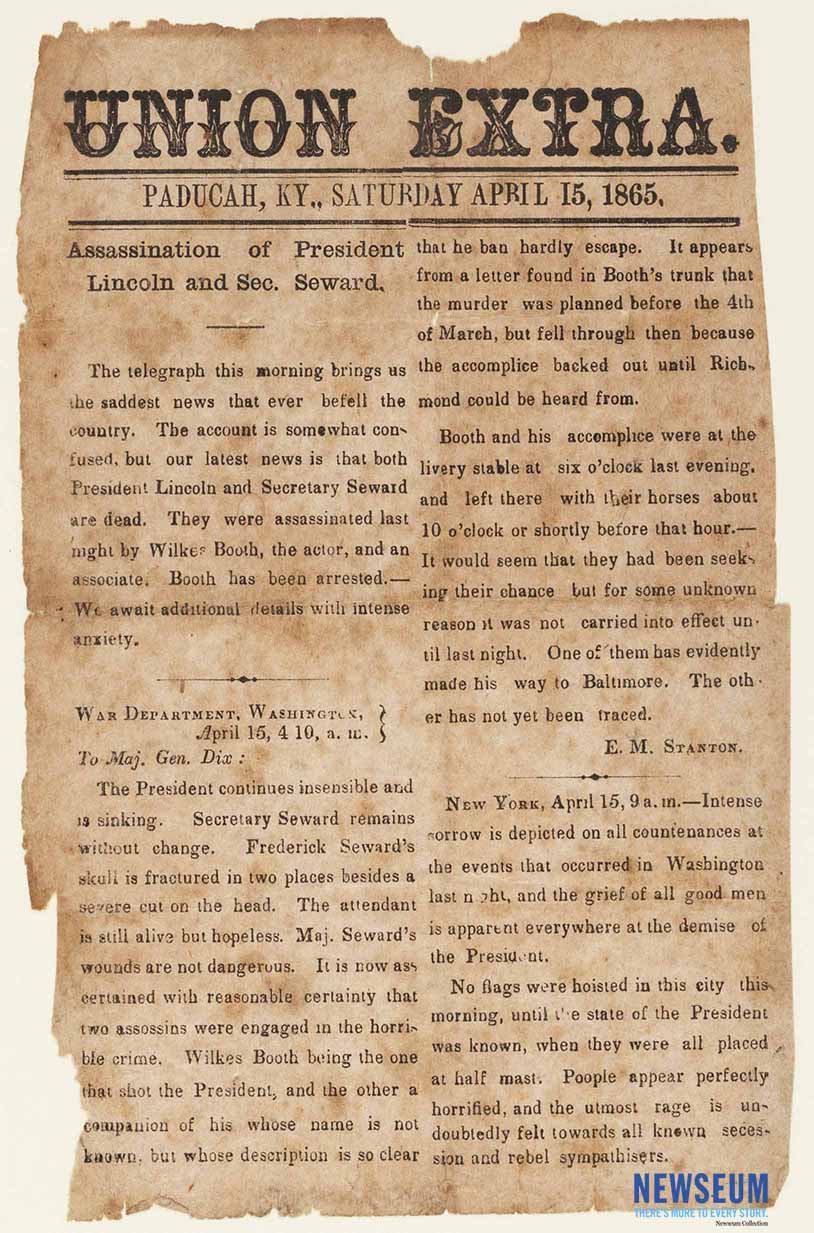
-
Description
This broadside extra reports on the assassination of President Abraham Lincoln. It falsely states that Secretary William H. Seward was killed and that John Wilkes Booth was arrested. The broadside contains a 4:10 a.m. dispatch from Secretary of War Edwin M. Stanton to Major General John A. Dix with the latest information. There is a report from New York describing the public's grief and the rage "undoubtedly felt towards all known secession and rebel sympathisers [sic]."
-
Source
HN-1865-011084
-
Rights
Use of this item for research, teaching, and private study is permitted with proper citation and attribution as follows: Courtesy, Newseum Collection. Reproduction of this item for publication, broadcast, or commercial use requires written permission. For permission, please contact the Newseum.
-
Creator
[s.n.]
-
Publisher
-
Date
April 15, 1865
-
Material
Newspaper
from Apr. 28, 1865
Illinois Daily State Journal, April 28, 1865
-
Full Title
Illinois Daily State Journal, April 28, 1865
-
Description
Interior page report in the Illinois Daily State Journal providing details on President Lincoln's funeral procession and his upcoming burial in Springfield, Illinois. The paper also reports extensively on the death of John Wilkes Booth and the capture of David E. Herold, including an official dispatch from Secretary of War Edwin M. Stanton to Major General John A. Dix. Known as "mourning rules," the wide vertical lines between the newspaper columns represent grief over the loss of an important person.
-
Source
HN-1865-011138B
-
Rights
Use of this item for research, teaching, and private study is permitted with proper citation and attribution as follows: Courtesy, Newseum Collection. Reproduction of this item for publication, broadcast, or commercial use requires written permission. For permission, please contact the Newseum.
-
Tags
-
Cite this Item
Baker & Phillips. "Illinois Daily State Journal, April 28, 1865". Baker & Phillips. Remembering Lincoln. Web. Accessed October 29, 2025. https://rememberinglincoln.fords.org/node/625
from Apr. 28, 1865
Illinois Daily State Journal, April 28, 1865

-
Description
Interior page report in the Illinois Daily State Journal providing details on President Lincoln's funeral procession and his upcoming burial in Springfield, Illinois. The paper also reports extensively on the death of John Wilkes Booth and the capture of David E. Herold, including an official dispatch from Secretary of War Edwin M. Stanton to Major General John A. Dix. Known as "mourning rules," the wide vertical lines between the newspaper columns represent grief over the loss of an important person.
-
Source
HN-1865-011138B
-
Rights
Use of this item for research, teaching, and private study is permitted with proper citation and attribution as follows: Courtesy, Newseum Collection. Reproduction of this item for publication, broadcast, or commercial use requires written permission. For permission, please contact the Newseum.
-
Creator
Baker & Phillips
-
Publisher
Baker & Phillips
-
Date
April 28, 1865
-
Material
Newspaper
from Apr. 15, 1865
Illinois Daily State Journal, April 15, 1865
-
Full Title
Illinois Daily State Journal, April 15, 1865
-
Description
Interior page report in the Illinois Daily State Journal providing details on the assassination of President Abraham Lincoln and the attempted assassination of Secretary William Henry Seward. The article contains a 1:30 a.m. official dispatch from Secretary of War Edwin M. Stanton to Major General John A. Dix advising him of the attack. Known as "mourning rules," the wide vertical lines between the newspaper columns represent grief over the loss of an important person.
-
Source
HN-1865-011062B
-
Rights
Use of this item for research, teaching, and private study is permitted with proper citation and attribution as follows: Courtesy, Newseum Collection. Reproduction of this item for publication, broadcast, or commercial use requires written permission. For permission, please contact the Newseum.
-
Tags
-
Cite this Item
Baker & Phillips. "Illinois Daily State Journal, April 15, 1865". Baker & Phillips. Remembering Lincoln. Web. Accessed October 29, 2025. https://rememberinglincoln.fords.org/node/624
from Apr. 15, 1865
Illinois Daily State Journal, April 15, 1865
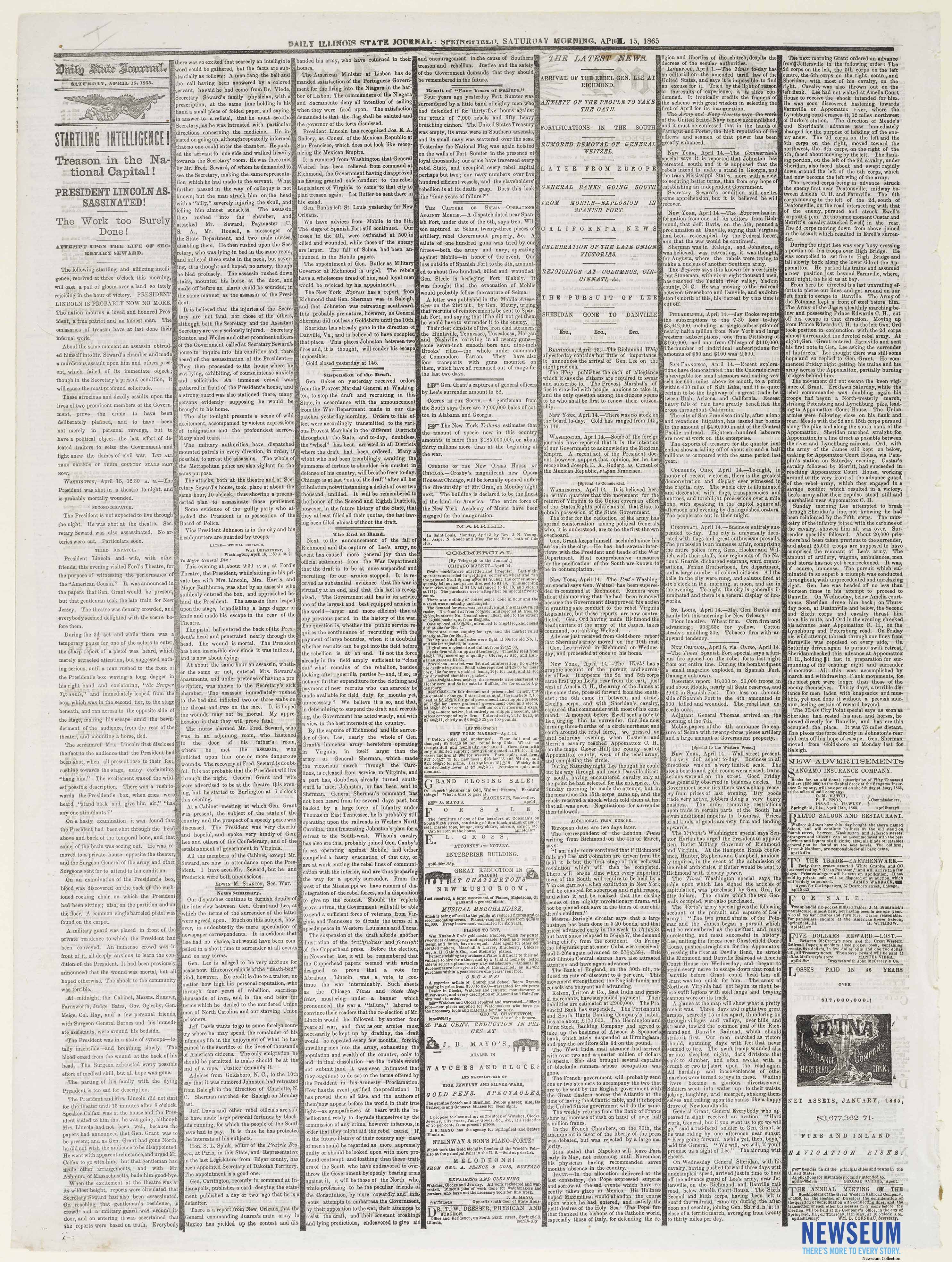
-
Description
Interior page report in the Illinois Daily State Journal providing details on the assassination of President Abraham Lincoln and the attempted assassination of Secretary William Henry Seward. The article contains a 1:30 a.m. official dispatch from Secretary of War Edwin M. Stanton to Major General John A. Dix advising him of the attack. Known as "mourning rules," the wide vertical lines between the newspaper columns represent grief over the loss of an important person.
-
Source
HN-1865-011062B
-
Rights
Use of this item for research, teaching, and private study is permitted with proper citation and attribution as follows: Courtesy, Newseum Collection. Reproduction of this item for publication, broadcast, or commercial use requires written permission. For permission, please contact the Newseum.
-
Creator
Baker & Phillips
-
Publisher
Baker & Phillips
-
Date
April 15, 1865
-
Material
Newspaper
from Apr. 30, 1865
President Lincoln's assassination
-
Full Title
La Sociedad: Periódico Político y Literario
-
Description
Reprint of dispatches printed in Boletin telegráfico, published in New York, the morning of April 15, 1865. First dispatch (12:30am): President Lincoln was shot while attending a theater performance. President mortally wounded. Second dispatch: repeats news about the president and adds that Secretary Seward was also "assassinated." Third dispatch (3:30am): describes the events at Ford’s theater, Mr. Lincoln and his wife went to see "Our American Cousin." Originally General Grant was also supposed to attend but had left that afternoon to go to New Jersey. Fourth dispatch: confusion, rumors about Secretary Seward’s assassination. Description of the incident at the Seward household. An assailant went to the house of Mr. Seward under the pretense that he had been sent by Dr. Verdi, Mr. Seward’s doctor, with a prescription. He attacked Mr. Seward and other people present. Mr. Seward’s wounds not considered life-threatening. The assailant was able to get away. Metropolitan police conducting a manhunt of both assailants; the police obtained some clues about the identity of the president’s attacker. Vice President Johnson's house in the capital is guarded by a troop.
-
Source
Independent Mexico in newspapers, the 19th century; reel 226
-
Rights
This item may be reproduced and used for any purpose, including research, teaching, private study, publication, broadcast or commercial use, with the proper citation and attribution. Citation: Independent Mexico in newspapers, the 19th-century (microfilm set). LLILAS Benson Latin American Studies and Collections, the University of Texas at Austin.
-
Tags
-
Cite this Item
La Sociedad. "La Sociedad: Periódico Político y Literario". México : Imprenta de J.M. Andrade y F. Escalante. Remembering Lincoln. Web. Accessed October 29, 2025. https://rememberinglincoln.fords.org/node/513
from Apr. 30, 1865
La Sociedad: Periódico Político y Literario
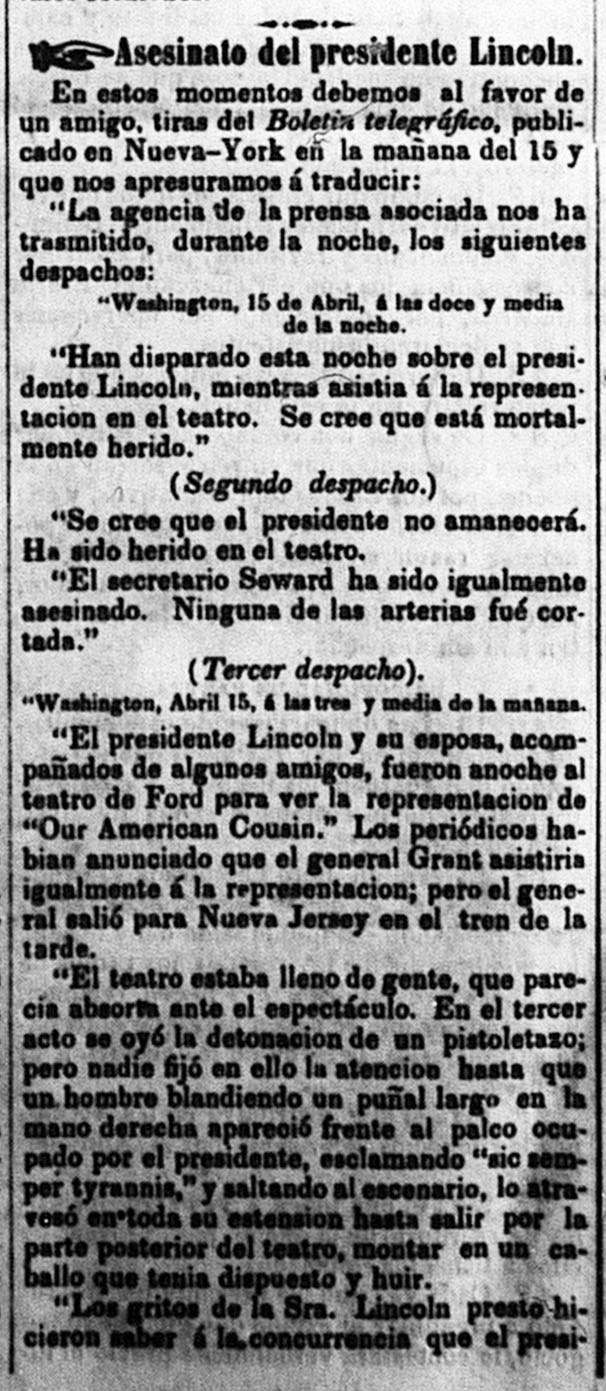
-
Description
Reprint of dispatches printed in Boletin telegráfico, published in New York, the morning of April 15, 1865. First dispatch (12:30am): President Lincoln was shot while attending a theater performance. President mortally wounded. Second dispatch: repeats news about the president and adds that Secretary Seward was also "assassinated." Third dispatch (3:30am): describes the events at Ford’s theater, Mr. Lincoln and his wife went to see "Our American Cousin." Originally General Grant was also supposed to attend but had left that afternoon to go to New Jersey. Fourth dispatch: confusion, rumors about Secretary Seward’s assassination. Description of the incident at the Seward household. An assailant went to the house of Mr. Seward under the pretense that he had been sent by Dr. Verdi, Mr. Seward’s doctor, with a prescription. He attacked Mr. Seward and other people present. Mr. Seward’s wounds not considered life-threatening. The assailant was able to get away. Metropolitan police conducting a manhunt of both assailants; the police obtained some clues about the identity of the president’s attacker. Vice President Johnson's house in the capital is guarded by a troop.
-
Source
Independent Mexico in newspapers, the 19th century; reel 226
-
Rights
This item may be reproduced and used for any purpose, including research, teaching, private study, publication, broadcast or commercial use, with the proper citation and attribution. Citation: Independent Mexico in newspapers, the 19th-century (microfilm set). LLILAS Benson Latin American Studies and Collections, the University of Texas at Austin.
-
Creator
La Sociedad
-
Publisher
México : Imprenta de J.M. Andrade y F. Escalante
-
Date
April 30, 1865
from May. 1, 1865
"Assassination of President Lincoln and Secretary Seward"
-
Full Title
El Pájaro Verde
-
Description
Newspaper article with details about the assassination of President Lincoln. Wires from Edwin M. Stanton, Secretary of War to Major General Dix informing him about the assassination of President Lincoln and injuries suffered by Mr. Seward, his son Frederick Seward and a house servant. News printed in the Diario de la Marina: description of the incident at Mr. Seward’s house (the attack and type of injuries suffered). J. Wilkes Booth is identified as President Lincoln’s killer. Description of the shock felt throughout; customs and businesses closed (banks, stores, and warehouses) in a sign of mourning. It also mentions that gold speculators suspended their operations as a sign of "modesty" (mourning).
-
Source
Independent Mexico in newspapers, the 19th century; reel 182
-
Rights
This item may be reproduced and used for any purpose, including research, teaching, private study, publication, broadcast or commercial use, with the proper citation and attribution. Citation: Independent Mexico in newspapers, the 19th-century (microfilm set). LLILAS Benson Latin American Studies and Collections, the University of Texas at Austin.
-
Tags
-
Cite this Item
El Pájaro Verde. "El Pájaro Verde". México : Imp. de M. Villanueva. Remembering Lincoln. Web. Accessed October 29, 2025. https://rememberinglincoln.fords.org/node/511
from May. 1, 1865
El Pájaro Verde
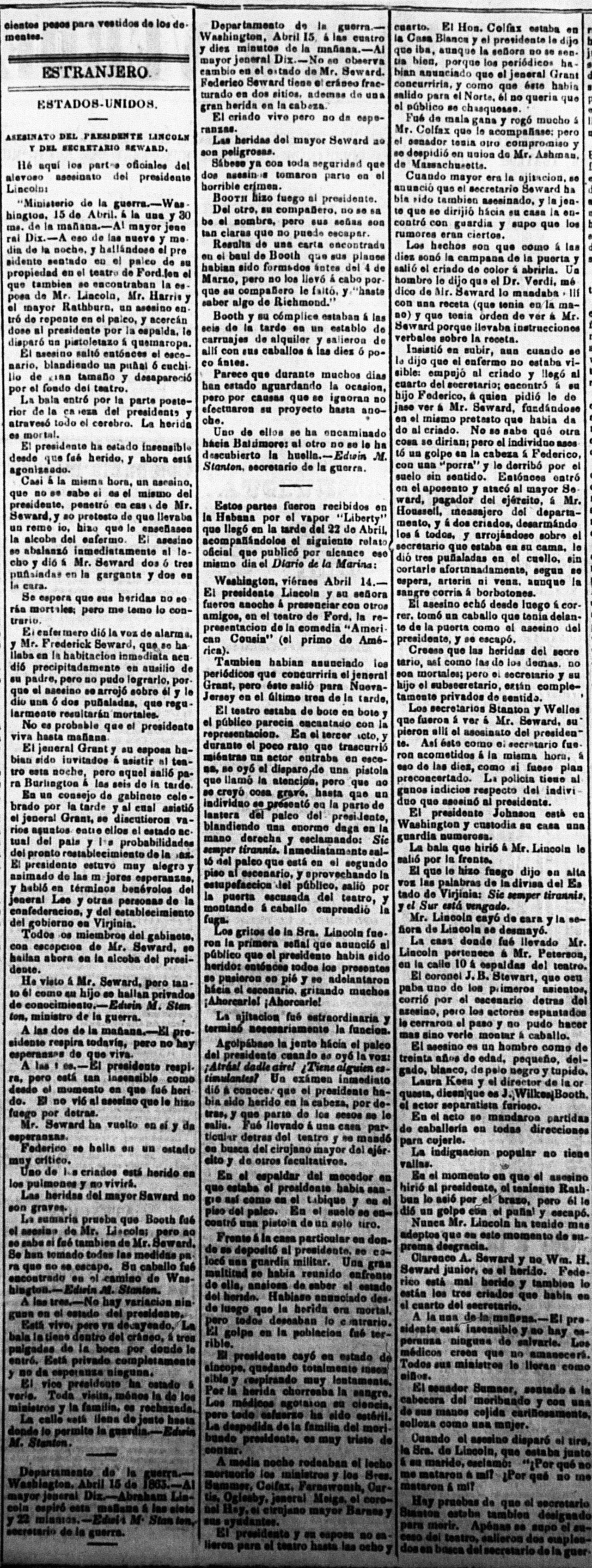
-
Description
Newspaper article with details about the assassination of President Lincoln. Wires from Edwin M. Stanton, Secretary of War to Major General Dix informing him about the assassination of President Lincoln and injuries suffered by Mr. Seward, his son Frederick Seward and a house servant. News printed in the Diario de la Marina: description of the incident at Mr. Seward’s house (the attack and type of injuries suffered). J. Wilkes Booth is identified as President Lincoln’s killer. Description of the shock felt throughout; customs and businesses closed (banks, stores, and warehouses) in a sign of mourning. It also mentions that gold speculators suspended their operations as a sign of "modesty" (mourning).
-
Source
Independent Mexico in newspapers, the 19th century; reel 182
-
Rights
This item may be reproduced and used for any purpose, including research, teaching, private study, publication, broadcast or commercial use, with the proper citation and attribution. Citation: Independent Mexico in newspapers, the 19th-century (microfilm set). LLILAS Benson Latin American Studies and Collections, the University of Texas at Austin.
-
Creator
El Pájaro Verde
-
Publisher
México : Imp. de M. Villanueva
-
Date
May 1, 1865
from Apr. 29, 1865
President Lincoln assassinated
-
Full Title
El Pájaro Verde
-
Description
Newspaper article about news received from a wire that President Lincoln died. Mr. Seward and Frederick Seward are also listed as dead. Also mentions that Mr. Lincoln’s killer, the actor Wilkes Booth, has been captured.
-
Source
Independent Mexico in newspapers, the 19th century; reel 182
-
Rights
This item may be reproduced and used for any purpose, including research, teaching, private study, publication, broadcast or commercial use, with the proper citation and attribution. Citation: Independent Mexico in newspapers, the 19th-century (microfilm set). LLILAS Benson Latin American Studies and Collections, the University of Texas at Austin.
-
Tags
-
Cite this Item
El Pájaro Verde. "El Pájaro Verde". México : Imp. de M. Villanueva. Remembering Lincoln. Web. Accessed October 29, 2025. https://rememberinglincoln.fords.org/node/510
from Apr. 29, 1865
El Pájaro Verde
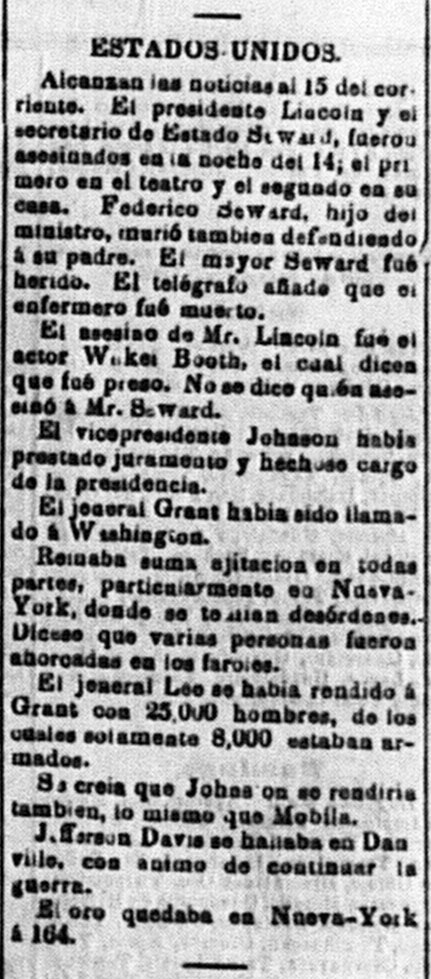
-
Description
Newspaper article about news received from a wire that President Lincoln died. Mr. Seward and Frederick Seward are also listed as dead. Also mentions that Mr. Lincoln’s killer, the actor Wilkes Booth, has been captured.
-
Source
Independent Mexico in newspapers, the 19th century; reel 182
-
Rights
This item may be reproduced and used for any purpose, including research, teaching, private study, publication, broadcast or commercial use, with the proper citation and attribution. Citation: Independent Mexico in newspapers, the 19th-century (microfilm set). LLILAS Benson Latin American Studies and Collections, the University of Texas at Austin.
-
Creator
El Pájaro Verde
-
Publisher
México : Imp. de M. Villanueva
-
Date
April 29, 1865
from Apr. 30, 1865
Mr. Lincoln assassinated
-
Full Title
L'Estafette: Journal Français
-
Description
Newspaper article includes wire messages with details about the President’s assassination and a public notice from Marcus Otterbourg, U.S. Consul, asking American citizens residing in Mexico City to meet at the U.S. Consulate office on April 30, 1865 to decide on an appropriate action.
-
Source
Independent Mexico in newspapers, the 19th century; reel 279
-
Rights
This item may be reproduced and used for any purpose, including research, teaching, private study, publication, broadcast or commercial use, with the proper citation and attribution. Citation: Independent Mexico in newspapers, the 19th-century (microfilm set). LLILAS Benson Latin American Studies and Collections, the University of Texas at Austin.
-
Tags
-
Cite this Item
L'Estafette. "L'Estafette: Journal Français". México : Ch. de Barrès et J.E. Caire. Remembering Lincoln. Web. Accessed October 29, 2025. https://rememberinglincoln.fords.org/node/509
from Apr. 30, 1865
L'Estafette: Journal Français

-
Description
Newspaper article includes wire messages with details about the President’s assassination and a public notice from Marcus Otterbourg, U.S. Consul, asking American citizens residing in Mexico City to meet at the U.S. Consulate office on April 30, 1865 to decide on an appropriate action.
-
Source
Independent Mexico in newspapers, the 19th century; reel 279
-
Rights
This item may be reproduced and used for any purpose, including research, teaching, private study, publication, broadcast or commercial use, with the proper citation and attribution. Citation: Independent Mexico in newspapers, the 19th-century (microfilm set). LLILAS Benson Latin American Studies and Collections, the University of Texas at Austin.
-
Creator
L'Estafette
-
Publisher
México : Ch. de Barrès et J.E. Caire
-
Date
April 30, 1865
from Apr. 29, 1865
News of President Lincoln’s death reaches Mexico
-
Full Title
L'Estafette: Journal Français
-
Description
Newspaper article speculates about the effect of the president’s assassination on American policy and business concerns and questions who committed the crime and why.
-
Source
Independent Mexico in newspapers, the 19th century; reel 279
-
Rights
This item may be reproduced and used for any purpose, including research, teaching, private study, publication, broadcast or commercial use, with the proper citation and attribution. Citation: Independent Mexico in newspapers, the 19th-century (microfilm set). LLILAS Benson Latin American Studies and Collections, the University of Texas at Austin.
-
Tags
-
Cite this Item
L'Estafette. "L'Estafette: Journal Français". México : Ch. de Barrès et J.E. Caire. Remembering Lincoln. Web. Accessed October 29, 2025. https://rememberinglincoln.fords.org/node/508
from Apr. 29, 1865
L'Estafette: Journal Français

-
Description
Newspaper article speculates about the effect of the president’s assassination on American policy and business concerns and questions who committed the crime and why.
-
Source
Independent Mexico in newspapers, the 19th century; reel 279
-
Rights
This item may be reproduced and used for any purpose, including research, teaching, private study, publication, broadcast or commercial use, with the proper citation and attribution. Citation: Independent Mexico in newspapers, the 19th-century (microfilm set). LLILAS Benson Latin American Studies and Collections, the University of Texas at Austin.
-
Creator
L'Estafette
-
Publisher
México : Ch. de Barrès et J.E. Caire
-
Date
April 29, 1865

